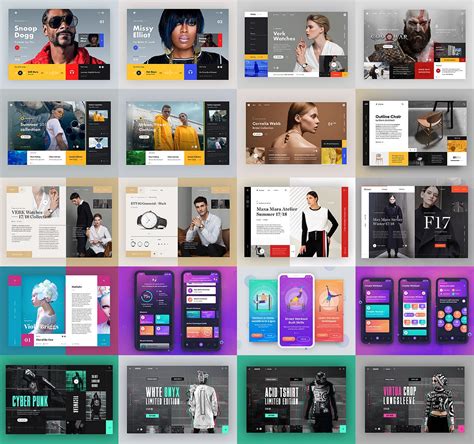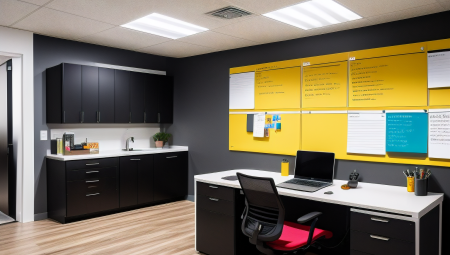Are you passionate about creating digital experiences that are both visually appealing and user-friendly? As technology continues to evolve, the role of a User Interface (UI) designer has become increasingly crucial in the development of websites, mobile apps, and other digital products. In this blog post, we will explore the various aspects of becoming a successful UI designer, from understanding the fundamentals of User Experience (UX) to mastering the art of visual design. We will delve into the importance of user-centered design principles, effective information architecture, responsive design techniques, intuitive navigation structures, and optimizing user interactions and feedback. Additionally, we will discuss the use of prototyping tools for iterative design and the importance of collaborating with developers for seamless implementation. Whether you’re new to the field or looking to enhance your skills, this post will provide valuable insights into the world of UI design. Join us as we explore the exciting world of crafting digital experiences!
Table of Contents
Understanding the Role of a UI Designer
A UI designer plays a critical role in the creation of digital products and services. They are responsible for designing the look and feel of a website or application, ensuring that it is visually appealing and user-friendly. This involves creating wireframes, mockups, and prototypes to communicate their design ideas.
Furthermore, UI designers collaborate closely with UX designers and front-end developers to ensure that the final product meets the needs and expectations of the end user. They are also responsible for staying updated on design trends and best practices in order to deliver high-quality user interfaces.
Overall, a UI designer must have a strong understanding of visual design principles, as well as proficiency in design tools such as Adobe XD, Sketch, or Figma. They should also possess excellent communication and teamwork skills to effectively collaborate with other members of the design and development team.
In conclusion, understanding the role of a UI designer is crucial in the successful development of digital products. Their expertise in visual design and user interface principles is essential in creating engaging and intuitive user experiences.
Developing a Strong Visual Design Sense
Developing a strong visual design sense is crucial for UI designers as it plays a fundamental role in creating attractive and effective user interfaces. A strong visual design sense involves understanding the principles of design, such as balance, contrast, emphasis, and rhythm, and knowing how to apply them to create visually appealing designs.
UI designers need to develop an eye for detail and be able to use color theory and typography to create visually harmonious interfaces that effectively convey the intended message to the users. They should also be familiar with the latest design trends and be able to adapt their visual design sense to create modern and innovative user interfaces.
Furthermore, developing a strong visual design sense requires continuous learning and practice. UI designers should regularly seek inspiration from other designers’ work and experiment with different design tools and techniques to refine their skills and develop a unique visual design style.
Ultimately, by developing a strong visual design sense, UI designers can create interfaces that not only look aesthetically pleasing but also effectively communicate with the users and enhance their overall user experience.
Mastering the Fundamentals of User Experience (UX)
When it comes to User Experience (UX), mastering the fundamentals is crucial for creating products and services that provide a seamless and enjoyable experience for users. From understanding the needs and desires of users to designing intuitive interfaces, a strong foundation in UX fundamentals is essential for any designer or developer.
One of the key aspects of mastering the fundamentals of UX is understanding the principles of usability. This involves creating interfaces that are easy to use, efficient, and provide a positive user experience. By focusing on usability, designers can ensure that their products and services meet the needs of their target audience and are easy to navigate.
Additionally, mastering the fundamentals of UX involves understanding the psychology of human behavior. This includes analyzing how users interact with digital interfaces, and using this knowledge to design products that are intuitive and user-friendly. By applying principles of psychology to UX design, designers can create more engaging and effective experiences for users.
Overall, mastering the fundamentals of User Experience (UX) is essential for creating products and services that not only meet the needs of users, but also provide a seamless and enjoyable experience. By focusing on usability, human behavior, and intuitive design, designers and developers can ensure that their products and services stand out in today’s competitive digital landscape.
Applying User-Centered Design Principles
When it comes to creating an effective and user-friendly interface, user-centered design principles play a crucial role. This approach puts the user at the center of the design process, focusing on their needs, preferences, and behaviors to create a seamless and intuitive experience.
By applying user-centered design principles, designers can gain valuable insights into their target audience, allowing them to create interfaces that are tailored to their specific requirements. This approach involves conducting thorough research, gathering user feedback, and iterating on designs to ensure that the final product meets the needs of the intended users.
One of the key aspects of user-centered design is the emphasis on usability testing. This involves observing how users interact with the interface, identifying pain points, and making necessary adjustments to improve the overall experience. By incorporating user feedback and testing throughout the design process, designers can create interfaces that are intuitive, efficient, and satisfying to use.
Ultimately, applying user-centered design principles is essential for creating interfaces that not only look visually appealing but also function seamlessly and meet the needs of the target audience. By prioritizing the user experience throughout the design process, designers can ensure that their interfaces are user-friendly, engaging, and ultimately successful.
Utilizing Effective Information Architecture
Utilizing Effective Information Architecture
When it comes to creating a successful website or application, one of the most critical aspects is information architecture. Information architecture refers to the organization and structure of content within a digital platform, ensuring that users can easily navigate and find the information they need. Effective information architecture is essential for providing a seamless user experience and ultimately achieving the goals of the digital product.
One key element of utilizing effective information architecture is understanding the target audience and their needs. By conducting user research and creating user personas, designers can gain valuable insights into how users think and behave, allowing them to create a structure that meets their needs. This user-centric approach is crucial for building a successful information architecture that resonates with the target audience.
In addition to understanding the user, utilizing effective information architecture also involves organizing content in a logical and intuitive manner. This includes creating clear navigation structures, categorizing content into meaningful groupings, and ensuring that information is easily accessible. By organizing content in a way that makes sense to users, designers can help users find what they need quickly and efficiently.
Furthermore, utilizing effective information architecture requires collaboration with other stakeholders, such as content creators and developers. Designers must work closely with these teams to ensure that the information architecture is not only well-designed but also technically feasible and scalable. By fostering strong communication and collaboration, designers can create an information architecture that is both user-friendly and sustainable in the long run.
Leveraging Responsive Design Techniques
Responsive design is a crucial aspect of modern web development, and leveraging responsive design techniques is essential for creating a seamless user experience on a variety of devices. With the increasing use of smartphones, tablets, and other mobile devices, it is more important than ever to ensure that websites and applications are optimized for different screen sizes and resolutions.
One key technique for leveraging responsive design is using media queries to apply specific styles based on the characteristics of the user’s device. By defining different breakpoints in the CSS, developers can tailor the presentation of content to ensure that it is displayed optimally on devices of all sizes. This allows for a more consistent and user-friendly experience across all platforms.
Another important aspect of leveraging responsive design techniques is flexible grid layouts. By using relative units such as percentages rather than fixed pixel values, developers can create designs that adapt fluidly to different screen sizes. This allows for a more dynamic and adaptable layout that can accommodate a wide range of devices without sacrificing visual appeal or functionality.
Furthermore, the use of responsive images is another crucial technique for ensuring that websites and applications look great across all devices. By utilizing the <picture> element or CSS rules, developers can deliver different image assets based on the user’s viewport size, ensuring that images are appropriately sized and optimized for different devices.
Creating Intuitive Navigation Structures
Creating Intuitive Navigation Structures
Creating intuitive navigation structures is essential for ensuring that users can easily navigate through a website or application. Intuitive navigation means that users can quickly find the information they are looking for without having to think too much about where to go. This can be achieved through clear labeling, logical groupings of content, and consistent placement of navigation elements.
One key aspect of creating intuitive navigation structures is conducting user research to understand how users typically navigate through similar types of websites or applications. By understanding user behavior, designers can create navigation structures that align with user expectations and mental models.
Another important consideration in creating intuitive navigation structures is the use of visual cues to guide users. This can include using typography and color to differentiate between different types of navigation elements, as well as employing icons and breadcrumbs to help users understand where they are within the website or application.
Ultimately, creating intuitive navigation structures requires a deep understanding of usability principles and a dedication to putting the user at the center of the design process. By prioritizing clarity and efficiency in navigation, designers can create a seamless user experience that allows users to effortlessly find and access the content they need.
Optimizing User Interactions and Feedback
Optimizing user interactions and feedback is a crucial aspect of designing a successful user interface. User interactions refer to the way users engage with a website or application, while feedback encompasses the responses and reactions that users provide. By optimizing these elements, designers can create a more seamless and enjoyable experience for their audience.
One way to optimize user interactions is to ensure that the interface is intuitive and easy to navigate. This can be achieved through clear navigation structures, intuitive gestures, and well-placed call-to-action buttons. By making it easy for users to find what they’re looking for and interact with the interface, designers can improve user satisfaction and engagement.
Feedback is another key element to optimize, as it provides valuable insights into how users are interacting with the interface. Designers can gather feedback through surveys, user testing, and analytics tools. By analyzing this feedback, designers can identify pain points and areas for improvement, ultimately leading to a more user-friendly interface.
Overall, optimizing user interactions and feedback is essential for creating a successful user interface. By focusing on intuitive navigation, clear feedback mechanisms, and continuous improvement based on user input, designers can create a more engaging and effective user experience.
Using Prototyping Tools for Iterative Design
When it comes to the process of iterative design, prototyping tools play a crucial role in helping designers refine their ideas and concepts. These tools enable designers to create interactive prototypes that can be tested and refined based on user feedback.
One of the key benefits of using prototyping tools is the ability to quickly iterate on design concepts, allowing for a more efficient and effective design process. By creating and testing prototypes, designers can gather valuable insights that can inform design decisions and improve the overall user experience.
Additionally, prototyping tools can help bridge the gap between designers and developers, providing a clear vision of the final product and ensuring a seamless implementation. This collaborative approach can lead to a more cohesive and user-friendly end result.
Overall, the use of prototyping tools for iterative design is an essential aspect of the design process, enabling designers to create and refine user-centered solutions that meet the needs of their target audience.
Collaborating with Developers for Seamless Implementation
When working as a UI/UX designer, one of the key aspects of creating a successful product is collaborating effectively with developers for seamless implementation. This collaboration is crucial for ensuring that the design vision is translated into a functional and user-friendly product.
Strong communication skills are essential for collaborating with developers. It is important to be able to clearly convey the design concepts and user-centered principles to the development team. This involves not only explaining the visual aspects of the design, but also the underlying information architecture and interactive elements.
Utilizing prototyping tools can also be incredibly beneficial for this collaboration. By creating interactive prototypes, designers can provide developers with a clear understanding of the expected user interactions and feedback. This helps to align the design and development teams towards a common goal.
Ultimately, collaborating with developers for seamless implementation is about fostering a shared understanding and mutual respect for each other’s expertise. By working together closely, UI/UX designers and developers can create products that not only look great but also function seamlessly for the end user.





